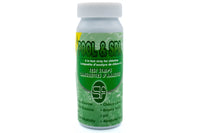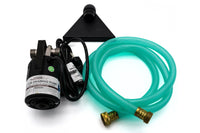Algae is something you expect to see in a lake or pond. It’s not something you expect to find in your own backyard. If you lift off your hot tub cover and see that there’s an algal bloom inside, something’s definitely gone wrong.
Don’t panic. Your hot tub isn’t completely ruined. You can remove algae from your hot tub–and with the right supplies and hot tub maintenance habits, you can prevent it from showing up ever again. This handy guide will walk you through what causes algae, how to prevent it from growing, and what to do if it shows up in your hot tub.
Understanding Hot Tub Algae
Algae is a simple plant that thrives in moist environments with access to sunlight and nutrients. Sometimes that moist environment is a lakeshore, and sometimes that environment happens to be the hot tub sitting next to your patio furniture.
Why is algae not great for hot tubbing? Algae will make the hot tub water cloudy or murky, not clean and clear. Algae is also slippery and slimy to the touch. Not only will this make sliding into the hot tub more dangerous, but it will feel really unpleasant on the skin–you’d want to hop out right away and take a shower.
You and your guests won’t be tempted to take a relaxing soak in the hot tub until the algae is gone.
What types of hot tub algae are there?
● Green Algae: The most common type of hot tub algae. It usually floats in the water or clings to surfaces, making the hot tub water appear murky and discolored.
● Yellow (Mustard) Algae: More resistant than green algae. It tends to form in shady areas of the hot tub and has a powdery or slimy texture.
● Black Algae: The toughest algae to eliminate. Black algae form deep-rooted colonies on surfaces, often requiring aggressive treatment.
Understanding these types of algae will help you recognize the problem early and take appropriate action to maintain a clean and safe hot tub environment.
The Common Causes of Algae Growth in Hot Tubs
Algae doesn’t pop up out of the blue. It usually shows up after inconsistent or improper hot tub water maintenance, which creates the perfect environment for it to thrive. So, what maintenance mistakes are bringing up algae in your hot tub?
Poor Water Circulation
Algae thrives in stagnant water. So, proper circulation is essential for keeping your hot tub clean. If your hot tub pump or filter isn’t running regularly, algae spores have a better chance of settling and multiplying.
Insufficient Sanitization
Chlorine and bromine are the primary sanitizers used in hot tubs to kill bacteria and algae. If sanitizer levels drop too low, it can lead to issues like cloudy hot tub water and algae overgrowth.
Unbalanced Water Chemistry
An improper pH balance, along with high phosphate and nitrate levels, can result in cloudy hot tub water and create an ideal environment for algae growth. If pH levels are too high, sanitizers become less effective, allowing algae to flourish.
Exposure to Sunlight
Algae rely on sunlight for photosynthesis, so hot tubs that are frequently exposed to direct sunlight without proper covers can encourage algae growth. Our high-quality hot tub covers can help prevent excessive sun exposure!
Organic Contaminants
Algae needs nutrients to thrive. In hot tubs, those nutrients can come from body oils, lotions, dirt, and debris. If your hot tub isn’t cleaned regularly, these contaminants can build up and encourage algae to thrive.
Dirty or Clogged Filters
Filters play a crucial role in trapping algae spores and other debris. If filters become clogged or aren’t cleaned frequently—or if you forget to change your filters when needed—they can become breeding grounds for algae.
Preventing Algae in Hot Tubs
Algae isn’t a random problem. It’s a sign that your hot tub’s water is unbalanced or not maintained properly. It’s the symptom of a larger problem.
Think of it like how mold and mildew can grow in basements. While the mold growing on the walls is a problem, it’s also a sign of bigger problems, like poor ventilation or leaky pipes. Getting rid of the mold is only part of the recovery process. You need to tackle the root causes of the mold growth, or else it will just keep coming back.
So, how can you stop algae from showing up? Or, if it’s already shown up before, how can you stop it from coming back again?
Maintain Proper Water Chemistry
Regularly test and balance your hot tub’s pH, alkalinity, and sanitizer levels to keep algae from growing. Aim for:
● pH levels between 7.2 and 7.8
● Free chlorine levels between 3-5 ppm or bromine levels between 4-6 ppm
● Alkalinity between 80-120 ppm
Keep the Hot Tub Covered
Using one of our high-quality hot tub covers when the tub is not in use helps protect your hot tub by preventing exposure to sunlight and airborne contaminants. This will reduce the risk of algae growth.
Consider buying a cover lifter to make removing and replacing the hot tub cover more convenient. This will come in handy when you’re doing a deep clean.
Run the Circulation System Daily
Ensure that your hot tub's pump runs for at least 4-8 hours a day to keep water circulating and prevent stagnation.
If you’re going to be away for long stretches of time (for example, for a month-long vacation), don’t leave your hot tub just sitting there. Drain it and clean it before you go away. This should prevent any nasty problems from cropping up while you’re gone.
Clean the Filters Regularly
To keep your filtration system running smoothly and prevent cloudy hot tub water, rinse your filters with fresh water at least once a week. Every month, give them a deeper clean using a dedicated filter cleaner to remove oils, grime, and buildup. And don’t forget—filters don’t last forever. You should change your filters once a year to ensure optimal performance and prevent algae-friendly conditions from forming.
Shock the Water Weekly
Use a non-chlorine or chlorine shock treatment weekly to maintain hot tub water clarity. Shock treatments eliminate harmful bacteria and oxidize organic matter, helping to disinfect your hot tub and prevent algae from getting a foothold.
Drain and Refill Every 3-4 Months
Over time, hot tub water accumulates contaminants that can lead to algae growth. Draining your hot tub water and refilling it every few months helps maintain water quality and reduces the chances of algae buildup.
Bathe Before Entering
Encourage everyone to rinse off before entering the hot tub to reduce the introduction of organic contaminants that feed algae. Everyday products like body lotions, shampoos, deodorants, and perfumes can wash off in the water and introduce nutrients that algae love. This is why public and private pools often require a quick rinse before swimming—your hot tub deserves the same level of care.

How to Remove Hot Tub Algae
If algae has already taken hold in your hot tub, don’t worry. Follow these steps to eliminate the problem and restore crystal-clear water.
Step 1: Drain the Hot Tub
The best way to get rid of algae is to start fresh. Draining your hot tub water completely helps remove as much of the algae as possible before deep cleaning.
Step 2: Scrub All Surfaces
Using a hot tub brush and a non-abrasive cleaner, scrub all interior surfaces, including the walls, seats, and jets, to remove algae buildup. This is a critical part of deep cleaning your hot tub, especially after an algae bloom.
Step 3: Clean and Rinse the Filters
Remove and thoroughly clean the hot tub filters using a filter cleaner. If the algae infestation is severe, you might want to replace the filter altogether.
Step 4: Refill and Shock the Water
Refill your hot tub with fresh water, then add a high dose of chlorine or bromine shock to disinfect your hot tub and kill any remaining algae spores. Run the pump for several hours to distribute the sanitizer evenly.
Step 5: Balance the Water Chemistry
Once the shock treatment is complete, knowing how to test hot tub water and adjust it to the proper levels will help prevent future algae growth and cloudy hot tub water.
Step 6: Run the Circulation System
Let the hot tub’s pump and filter run continuously for at least 24 hours to ensure all algae spores are removed.
Don't Let Algae Take Over
Your hot tub is supposed to be your private oasis. And your private oasis should feel pristine. So, if you notice that your hot tub is looking a little too swamp-like, don’t panic. Algae might be annoying, but it’s not the end of the world—and it definitely doesn’t mean your hot tub is ruined.
You can kick algae to the curb and bring your hot tub back to life. Here at The Cover Guy, we have all of the essentials you need to restore your water and get your hot tub back in great shape. We have everything from shock treatments to fresh hot tub filters.
With the right supplies and a little bit of effort, you can refresh your hot tub’s water and turn it into a private oasis again.










